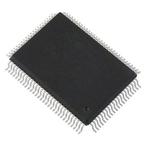The SERCOS interface controller SERCON816 is an integrated circuit for SERCOS interface communication systems. The SERCOS interface is a digital interface for communication between systems which have to exchange information cyclically at short, fixed intervals (62,5 s to 65 ms). It is appropriate for the synchronous operation of distributed control or test equipment (e.g. connection between drives and numeric control).
●A SERCOS interface communication system consists of one master and several slaves. These units are connected by a fiber optical ring. This ring starts and ends at the master. The slaves regenerate and repeat their received data or send their own telegrams. By this method the telegrams sent by the master are received by all slaves while the master receives data telegrams from the slaves. The optical fiber assures a reliable high-speed data transmission with excellent noise immunity.
●The SERCOS interface controller contains all the hardware-related functions of the SERCOS interface and considerably reduces the hardware costs and the computing time requirements of the microprocessor. It is the direct link between the electro-optical receiver and transmitter and the microprocessor that executes the control algorithms. The SERCON816 can be used both for SERCOS interface masters and slaves.
●The circuit contains the following functions (Fig. 1):A serial interface for making a direct connection with the optical receiver and transmitter of the fiber optic ring or with drivers to an electric ring or bus. Data and clock regeneration, the repeater for ring topologies and the serial transmitter and receiver are integrated. The signals are monitored and test signals generated. The serial interface operates up to 16 Mbaud without external circuitry.A dual port RAM (2048
● 16 bit) for control and communication data. The organization of the memory is flexible.Telegram processing for automatic transmission and monitoring of synchronous and data telegrams. Only transmission data which is intended for the particular interface user is processed. The transmitted data is either stored in the internal RAM (single or double buffer) or transferred via direct memory access (DMA). The transmission of service channel information over several communication cycles is executed automatically.
●In addition to the SERCOS interface the SERCON816 can also be used for other real-time communications tasks. As an alternative to the fiber optical ring also bus topologies with RS-485 signals are supported (Fig. 4). The SERCON816 is therefore suitable for a wide range of applications.
●Remark: The SERCON816 is based on the former SERCON410B SERCOS interface controller.
●Key Features
● Automatic transmission of synchronous and data telegrams in the communication cycle
● Modulation of power of optical transmitter diode
● Synchronization by external signal
● Flexible RAM configuration, communication data stored in RAM (single or double buffer) or transfer via DMA
● Automatic service channel transmission
● Timing control signals
● Compatible mode to SERCON410B SERCOS interface controller
● Watchdog to monitor software and external synchronization signals
● 100-pin plastic flat-pack casing
● Internal repeater for ring connections
● Maximum transmission rate of 16 Mbaud with internal clock recovery
● Single-chip controller for SERCOS interface
● 8/16-bit bus interface, Intel and Motorola control signals
● Real time communication for industrial control systems
● Data communications via optical fiber rings, RS 485 rings and RS 485 busses
● Full duplex operation
● Dual port RAM with 2048 word
●16-bit


